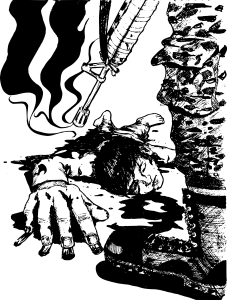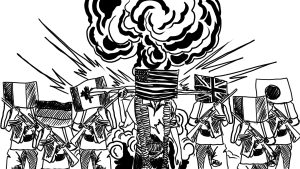Destructive effect of AFP bombings on environment and communities


The devastating impact of the Armed Forces of the Philippines’ indiscriminate bombing and shelling on the environment and civilian communities is undeniable.
These include physical damage to the environment, deformation of terrain and destruction of habitat or survival of wildlife, air and water pollution, noise, and contributing to greenhouse gas emissions that cause global warming. These also cause destruction of homes, farms, and endangerment of life on civilian communities and populated areas. This has led residents to flee their communities to crowded and precarious evacuation centers.
In a forum led by the Kalikasan People’s Network for the Environment (Kalikasan PNE) on May 24, environmental activists discussed the particular effects of these on some key biodiversity areas in the country.
According to the group’s report, at least seven major biodiversity areas and forest reserves were endangered by AFP bombing and shelling from June 2022 to the present. In total, at least 62 endemic species and more than half a million hectares of key biodiversity areas were affected during this period. The group’s report covers the mountains and forests of Bukidnon, Cagayan, Kalinga, Occidental Mindoro, Oriental Mindoro, Negros Occidental and Negros Oriental.
The AFP recently dropped two bombs using a drone on Mt. Katarugan in Barangay Lobo, Cantilan, Surigao del Sur on May 11. Located here is the Cabitoonan forest, which contains at least 23 species of endangered trees.
The forum also discussed the damage caused by the bombing and shelling carried out in the war games between the US and the Philippines. In the first half of the year, three war games were staged in the country’s sovereign territory in which live-fire exercises were conducted and various types of bombs were detonated causing harm to the forest and ocean ecosystems. These include the Balikatan exercises from April 11-18, followed by the Kasangga exercises with Australia and the recent joint naval drills in Bataan with the US and Japan.
Irreparable damage
From 2017 to 2022, the AFP dropped more than 591 bombs, fired 589 artillery shells and conducted 74 rounds of strafing. Incidents were recorded in the mountains and forests of Bukidnon, Cagayan, Kalinga, Samar, Panay and in the provinces of Mindoro, Negros, Surigao, Agusan, Davao, Cotabato, Lanao and Maguindanao. Many of these incidents are not disclosed to the public. In some incidents admitted by the AFP, the bombings were described as “close aerial support” despite the fact that these usually precede the movement of their ground troops in the area.
One of the cases is the destructive bombing of the Saldab Complex on November 2, 2021, which ignited a fire that razed the mountaintop in Gabunan, Barangay Dumalaguing, Impasug-ong, Bukidnon. The forest here has long been declared protected because it is adjacent to the protected Mt. Kitanglad Range. It serves as an extended habitat for endemic species of birds, including the Philippine eagle.
In Panay, the bomb dropped by the military in December 2021 left large craters. The craters near the farms were 20 feet wide and 15 feet deep. The bombardment and concurrent shelling caused trauma.
The AFP attack on Marawi City in 2017 was the most brutal and biggest AFP bombing campaign. More than 1,000 people were reported killed, and property and infrastructure damage were estimated to reach ₱17 billion. Until now, more than 80,300 people or 16,070 families, crammed-up in evacuation centers, have not returned home. It is estimated that the government squandered ₱5 billion to pulverize the city.









